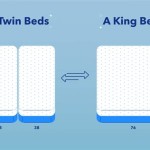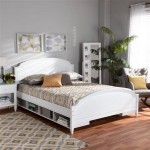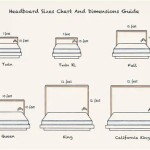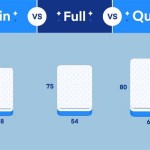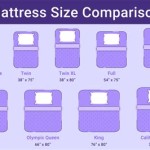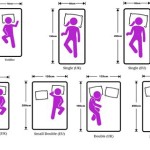What Size Mattress Is A Bunk Bed?
Bunk beds are a practical and space-saving solution for various living arrangements, from children's rooms to dormitories and vacation rentals. A crucial aspect of selecting a bunk bed is understanding the appropriate mattress size. Using the incorrect mattress size can compromise safety, comfort, and the overall functionality of the bunk bed. Furthermore, the dimensions of the mattress directly impact the fit within the bunk bed frame, potentially leading to instability or discomfort for the user.
The standard size for bunk bed mattresses is typically a twin size. However, variations exist, and confirming the specific measurements recommended by the bunk bed manufacturer is paramount. Ignoring these specifications can lead to safety hazards and a less-than-ideal sleeping experience. This article explores the various mattress sizes suitable for bunk beds, safety considerations, and factors to consider when making a purchasing decision.
Standard Twin Size for Bunk Beds
The most common mattress size for bunk beds is the twin size. A standard twin mattress measures approximately 39 inches in width and 75 inches in length. This size is well-suited for children, teenagers, and even some adults. Its compact dimensions allow for efficient use of space, making it ideal for smaller rooms or shared sleeping areas. Twin mattresses are also relatively affordable and readily available in a wide range of materials and comfort levels.
When selecting a twin mattress for a bunk bed, it is vital to consider the mattress thickness. Most bunk beds have a height restriction for the top bunk to ensure the safety rail adequately protects the sleeper. Generally, a mattress thickness of 6 to 8 inches is recommended for the top bunk. Exceeding this thickness could reduce the effectiveness of the safety rail, increasing the risk of falls. For the bottom bunk, a thicker mattress can be used, provided it fits comfortably within the frame and does not obstruct access.
The weight capacity of the bunk bed frame should also be considered when choosing a twin mattress. The combined weight of the mattress and the sleeper must not exceed the manufacturer's specified weight limit. Overloading the bunk bed can lead to structural damage and potential collapse, posing a significant safety risk. Checking the product specifications and weight restrictions before purchasing both the bunk bed and the mattress is imperative.
Alternative Mattress Sizes for Bunk Beds
While twin mattresses are the most prevalent choice for bunk beds, alternative sizes can be used depending on the design of the bunk bed frame. Some bunk beds are designed to accommodate full-size mattresses, while others may even support twin XL mattresses. Understanding the available options and their suitability for different age groups and space constraints is crucial. Custom bunk beds can also be constructed, opening the door to unique mattress size requirements.
A full-size mattress measures approximately 54 inches in width and 75 inches in length. This size provides more sleeping space than a twin mattress, making it suitable for older teenagers or adults who desire additional room to stretch out. Bunk beds that accommodate full-size mattresses are generally larger and require more floor space. They are often preferred in situations where comfort and individual space are prioritized over maximizing room occupancy.
Twin XL mattresses measure approximately 39 inches in width and 80 inches in length. These mattresses are slightly longer than standard twin mattresses, providing additional legroom for taller individuals. Twin XL mattresses are commonly found in college dormitories and are a good option for bunk beds used by young adults. However, it is essential to ensure that the bunk bed frame is specifically designed to accommodate a twin XL mattress, as a standard twin frame will be too short.
When considering alternative mattress sizes, it is equally important to pay attention to the mattress thickness and weight capacity. The same safety considerations that apply to twin mattresses also apply to full and twin XL mattresses. Adhering to the manufacturer's recommendations regarding mattress thickness and weight limits is crucial for maintaining the safety and integrity of the bunk bed structure. Furthermore, when selecting custom-made bunk beds, care should be taken to calculate the mattress size requirements and to check that the dimensions of the bed frame are consistent with the mattress to be used.
Safety Considerations for Bunk Bed Mattresses
Safety is paramount when selecting a mattress for a bunk bed, particularly for the top bunk. The correct mattress thickness, adequate safety rails, and adherence to weight restrictions are essential for preventing accidents and ensuring the well-being of the sleeper. Neglecting these safety considerations can lead to falls, injuries, and structural damage to the bunk bed. Ongoing monitoring and maintenance of the bunk bed are necessary to ensure that it remains safe and functional over time.
The mattress thickness for the top bunk should be carefully chosen to ensure that the safety rails provide adequate protection. Regulations often stipulate certain minimum rail heights above the mattress surface, and exceeding the recommended mattress thickness can compromise this safety feature. Regularly measuring the distance between the top of the mattress and the top of the safety rail is advisable to confirm that it meets the required standards. If the distance is insufficient, a thinner mattress may be necessary.
The strength and stability of the safety rails themselves are also important considerations. The rails should be securely attached to the bunk bed frame and free from any damage or defects. Regular inspections of the rails are crucial to identifying and addressing any potential issues before they lead to accidents. Additionally, educating children about the importance of not playing or climbing on the safety rails can further reduce the risk of falls.
Weight restrictions for both the bunk bed frame and the mattress must be strictly adhered to. Overloading the bunk bed can compromise its structural integrity, potentially leading to collapse. The combined weight of the mattress and the sleeper should never exceed the manufacturer's specified weight limit. Regularly checking the weight capacity and ensuring that it is not being exceeded is essential for maintaining the safety of the bunk bed.
In addition to these precautions, selecting a fire-retardant mattress is also advisable. Fire-retardant mattresses are designed to slow the spread of flames in the event of a fire, providing valuable time for evacuation. Checking for certifications from organizations like CertiPUR-US can help ensure that the mattress meets safety standards for fire resistance and chemical emissions.
Factors to Consider When Choosing a Bunk Bed Mattress
Beyond the size and safety considerations, several other factors influence the selection of a bunk bed mattress. These include the sleeper's age and weight, desired comfort level, mattress material, and budget. Evaluating these factors can help individuals make informed decisions and choose a mattress that meets their specific needs and preferences. The long-term use of the bunk bed should also be accounted for when choosing a mattress.
The sleeper's age and weight are important considerations when selecting a mattress. Children generally require less support than adults, so a softer mattress may be suitable. However, heavier individuals may need a firmer mattress to provide adequate support and prevent sagging. Consider the age group and weight range of the intended users when making a decision.
The desired comfort level is subjective and depends on personal preferences. Some people prefer a soft, plush mattress, while others prefer a firmer, more supportive mattress. Experimenting with different mattress types and firmness levels can help individuals determine their ideal comfort preference. Reading online reviews and seeking recommendations from others can also provide valuable insights.
Mattress material is another important factor to consider. Common mattress materials include innerspring, memory foam, latex, and hybrid combinations. Each material offers unique benefits and drawbacks in terms of comfort, support, durability, and price. Innerspring mattresses are generally more affordable and offer good support, while memory foam mattresses conform to the body and provide pressure relief. Latex mattresses are known for their durability and breathability, and hybrid mattresses combine the benefits of multiple materials. Furthermore, consideration should be given to the possibility of allergies to different materials. Checking the hypoallergenic qualities of the mattress is essential to ensuring the comfort and health of the sleeper.
Budget is always a consideration when purchasing a mattress. Bunk bed mattresses range in price from relatively inexpensive to quite expensive. Setting a budget before beginning the search can help narrow down the options and prevent overspending. Remember that quality and durability are important factors to consider, as a higher-quality mattress may last longer and provide better support over time.
Finally, consider the long-term use of the bunk bed. If the bunk bed will primarily be used by children who will eventually outgrow it, a more basic and affordable mattress may suffice. However, if the bunk bed will be used for a longer period or by adults, investing in a higher-quality and more durable mattress is advisable. Considering the potential lifespan of the bunk bed and the mattress can help individuals make a more informed purchasing decision.

Bunk Bed Mattress Sizes Guide Eachnight

Bunk Bed Mattress Sizes And Dimensions Guide Sleep Junkie

How To Choose An Adult Bunk Bed Size Adultbunkbeds Com

Rv Mattress Sizes Guide Dreamcloud

Bunk Bed Mattress Sizes How To Choose Yours

Bunk Bed Mattress Sizes A Guide For Safety And Comfort

Discovery World Furniture Premium Staircase Twin Over Full Bunk Bed

What Size Mattress For Bunk Beds Clafbebe

Continental Sleep Twin Size 5 Inch Medium Firm Foam Mattress With Heavy Duty Metal Bunk Bed Ideal For Kids Teens 33

What Mattress Should You Use For A Bunk Bed

